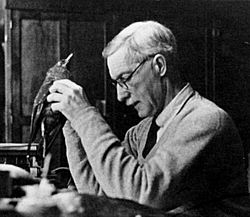Annie Meinertzhagen facts for kids
Quick facts for kids
Annie Constance Jackson
HMBOU
|
|
|---|---|
 |
|
| Born | 2 June 1889 Swordale, Ross-shire, Scotland
|
| Died | 6 July 1928 (aged 39) Swordale, Ross-shire, Scotland
|
| Cause of death | Gunshot wound |
| Education | Imperial College London |
| Spouse(s) | Richard Meinertzhagen |
| Children | 3 |
| Awards | Honorary Member of the British Ornithological Union (1915) |
| Scientific career | |
| Fields | ornithology |
| Academic advisors | Ernest MacBride |
Annie Meinertzhagen (born June 2, 1889 – died July 6, 1928) was a Scottish scientist who studied birds. She was known as an ornithologist. Annie made important discoveries about how British birds, especially ducks and waders, change their feathers (this is called moulting). In 1921, she married another bird expert, Richard Meinertzhagen. Annie died from a gunshot.
Contents
Early Life and Bird Studies
Annie was born Anne Constance Jackson on June 2, 1889. Her parents were Major Randle Jackson and Emily V. Baxter. They lived in a village called Swordale in the Scottish Highlands.
From a young age, Annie loved natural history, especially birds. She studied zoology (the study of animals) for three years. She went to the Imperial College of Science in London. Her younger sister, Dorothy, also became a scientist, studying insects.
In 1915, Annie published a scientific paper. She wrote it with her teacher, Ernest MacBride. The paper was about how colors are passed down in stick insects.
Discoveries About Birds
Annie did a lot of her early bird research in Swordale. She also studied birds along the Cromarty and Dornoch firths (narrow inlets of the sea). She started writing about the local birds in 1909.
Annie was very interested in bird migration. This is when birds travel long distances between different places. She wrote to lighthouse keepers who sent her rare bird specimens.
- She collected the first Scottish autumn specimens of the yellow-browed warbler.
- She was the first bird expert to show that a type of common redshank from Iceland visits Britain.
Annie often worked with her cousin, Evelyn V. Baxter, who also studied birds.
Marriage and Expeditions
In March 1921, Annie married Richard Meinertzhagen. He was a British soldier and also an ornithologist.
For part of their honeymoon, Annie continued her research. She visited Walter Rothschild's bird museum in Tring.
Annie traveled a lot for her bird studies:
- In 1921, she went to Copenhagen.
- In 1923, she traveled to Egypt and Palestine.
- In 1925, she visited Madeira.
- In the winter of 1925–26, she went to India. She joined her husband on an expedition to Sikkim and southern Tibet. They were hunting birds and mammals in the Himalayas.
Annie and Richard had three children: Anne (born 1921), Daniel (born 1925), and Randle (born 1928).
Death
Annie Meinertzhagen died at her home in Swordale on July 6, 1928. This was just over three months after her third child was born. She died from a gunshot.
Recognition
Annie Meinertzhagen received special honors for her work:
- In 1915, she became an Honorary Lady Member of the British Ornithologists' Union.
- In 1919, she became a Corresponding Member of the American Ornithologists' Union.
Other scientists honored her by naming birds after her:
- The Antipodes snipe (Coenocorypha aucklandica meinertzhagenae) was named after her in 1927.
- The subspecies Anthus cinnamomenus annae and Ammomanes deserti annae were also named in her honor.


